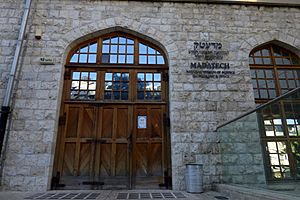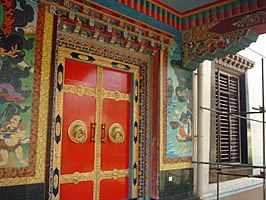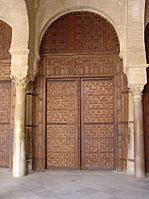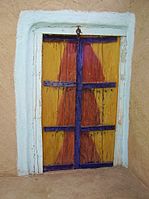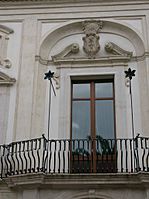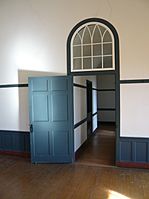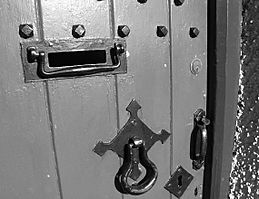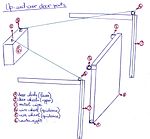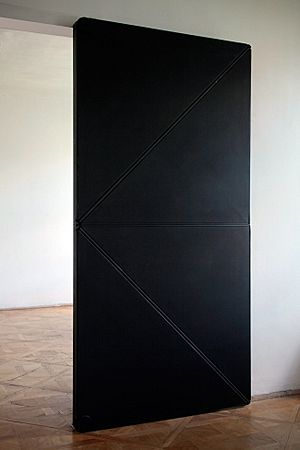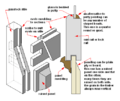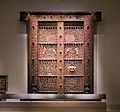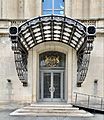Door facts for kids
A door is a flat, strong object that you can open and close. It lets people go into or out of a room or building. You find doors in houses, buildings, cars, and even cages.
Doors are important for many reasons:
- They let people, animals, and things pass through. Some doors are only for emergencies, like an emergency exit.
- They help keep cold or hot air in or out. Think of a refrigerator door!
- They give you privacy and block noise, so others can't see or hear what's happening inside.
- They keep people safe inside a car or other vehicle.
- They let you decide who can come in. Many doors have a lock for safety.
Contents
Different Door Styles

There are many types of doors, each with a special use. The most common is the single-leaf door. This is one solid panel that fills the doorway.
Here are some other types:
- A double-leaf door or French window has two panels. Each panel opens from its own side of the doorway.
- A half door or Dutch door is split in half horizontally. The top part can open while the bottom stays closed. This was first used for feeding horses, but now it's also in homes.
- Saloon doors are light swing doors. They are often found in public bars, especially in old American Western movies. They can swing both ways and usually close by themselves using springs.
- A blind door or jib door is hidden. It looks just like the wall around it, so you don't notice it's a door.
- A French door has a frame with clear glass panels. A pair of these doors is called a French window. They let in lots of light and often open onto a balcony or garden.
- A louvred door has angled slats. These slats let air move through but still give you privacy. They are often used for wardrobes or drying rooms.
- A composite door is a strong, single door. It can be solid or have glass. It's often filled with foam for extra strength.
- A steel security door is made of strong steel. It's used for places like vaults to keep things very safe.
- A flush door is completely smooth. It's made of plywood or MDF over a light wood frame. These are common inside homes.
- A moulded door is like a flush door, but its surface has a shaped design.
- A ledge and brace door is made of vertical wood planks. These planks are held together by horizontal and sometimes diagonal pieces of wood.
- A wicket door is a small door built into a much bigger door. It lets people go through without opening the large door. You might see these on a big church door or a garage door.
- A bifold door has several sections that fold up. They are often used for closets or to connect rooms. They can open wide, folding neatly against each other.
- A sliding glass door is made of glass and slides open. It often leads to a backyard or patio.
- False doors are wall decorations that look like doors. In ancient Egyptian architecture, they were common in tombs. They were thought to be a gate to the afterlife.
- Door Designs
-
A front door with a letter box, door knocker, latch, and locks
How Doors Open
Hinged Doors
Most doors have hinges on one side. This lets the door swing open in one direction. Usually, the hinges are vertical. Some doors, like garage doors, might have horizontal hinges above the opening.
- A swing door has special hinges that let it open both inwards and outwards. It usually has springs to keep it closed.
- A selfbolting door moves sideways as it closes. This makes the door itself act like a giant bolt, adding more security.
- A Dutch door or stable door has two halves. The top half can open separately from the bottom half.
- A garden door looks like a French window. But it's more secure because only one door opens.
Sliding Doors
Sliding doors move along tracks. They are great for saving space or for a modern look.
- A bypass door has two or more sections that slide past each other on parallel tracks. They are often used for closets.
- Doors that slide into a space inside the wall are called pocket doors.
- Sliding glass doors are common in homes. They often lead to a backyard or patio.
Rotating Doors
- A revolving door has several sections that spin around a central pole. It lets people go in and out at the same time. It also helps keep the air inside separate from the air outside.
- A pivot door spins on a special point, not on hinges at the edge. This point is usually a bit away from the door's edge.
High-Speed Doors
A high-speed door opens very quickly, sometimes up to 4 meters per second! These are mostly used in factories and industrial places. They help with things like moving products quickly or controlling temperature. They are built to open and close many times, often over 200,000 times a year.
Automatic Doors
Automatically opening doors open and close by themselves. They use electricity, springs, or both.
Here's how they usually work:
- A sensor detects someone coming. This can be a pressure sensor (like a mat you step on), an infrared beam, or a motion sensor (using microwaves).
- A remote control can also trigger the door, like for garage doors.
- Sometimes, you push or pull the door slightly, and it finishes opening by itself. These are called power-assisted doors.
Automatic doors also have safety sensors. These sensors stop the door if something is in its way. This prevents the door from hitting anyone. Modern automatic doors also stay open if the power goes out.
Other Door Types
- Up-and-over or overhead doors are often used in garages. They lift up and rest flat above the opening.
- A tambour door or roller door is made of narrow horizontal slats. It rolls up and down along tracks. You might see these on cabinets or entertainment centers.
- Inward opening doors can only be opened from outside a building. If they are locked, they can be dangerous in a fire because people inside can't escape. Many modern doors like this have a "breakaway" feature. This lets them be pushed open outwards in an emergency.
- Rebated doors are double doors that have an overlap where they meet. This helps them seal better.
- The Evolution Door is a special door invented by Klemens Torggler. It slides open but doesn't need tracks. It moves in a unique way using rotating panels.
Where Doors Are Used
Doors are used in many places for different reasons. They separate rooms inside buildings for convenience, privacy, and security. Doors also protect buildings from the outside, helping with climate control and safety.
Here are some special uses for doors:
- A blast-proof door is built to protect a building from explosions.
- A garden door is any door that opens to a backyard or garden. This often means French windows or sliding glass doors.
- A pet door (also called a cat flap or dog door) is a small opening in a door. It lets pets go in and out without opening the main door. Some pet doors are electronic and only open for pets with a special tag.
- A trapdoor is a door that lies flat in a ceiling or floor. You often need a ladder to reach it.
- A water door is a door that leads from a building directly to water, like a canal. These are common in places like Venice, Italy. They let you get into or out of a boat.
Images for kids
-
Roman wall painting of a fancy door in the Villa Boscoreale, 1st century AD
-
A glass door with Art Nouveau designs from the Singer House in Saint Petersburg, Russia
-
The "Gates of Paradise" door in the Florence Baptistery, made between 1425–1452
-
The entrance of the Kunsthistorisches Museum in Vienna, Austria
-
A clear awning over a door in Luxembourg
-
Traditional Chinese folding doors in The Old Museum of Wisteria
-
An Islamic door with geometric patterns in Morocco
-
A Romanesque door in Barfrestone, England
-
A Gothic door of the St Magnus Cathedral in Scotland
-
A Russian door in Saint Basil's Cathedral in Moscow
-
A Renaissance door in Gdańsk, Poland
-
A Baroque door in the Palace of Versailles in France
-
A Rococo door in Paris
-
An African door with a lock, from Burkina Faso
-
A decorated door from the Gandantegchinlen Monastery in Mongolia
-
A Gothic Revival door in Paris
-
A Rococo Revival door in Paris
-
An Art Nouveau metal and glass door in Nancy, France
-
A hinge on a door at the St Pancras railway station in London
See also
 In Spanish: Puerta para niños
In Spanish: Puerta para niños


